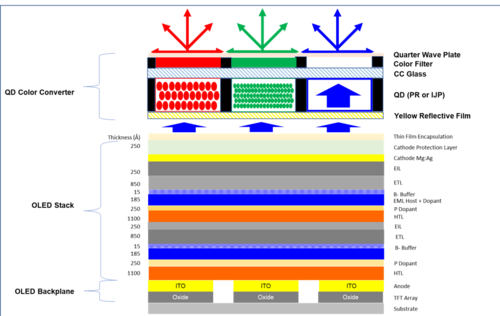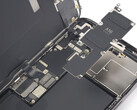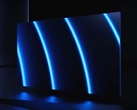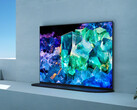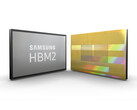OLED displays practically replaced the plasma standard for TVs back in 2013. As such, the technology remained quite expensive compared to LCD LEDs, despite it being easier to implement in smaller form-factors like smartphones. Developments in the past few years finally allowed LG and AUO to diversify the OLED panel sizes in order to implement them in 24-inch PC monitors and 15 / 17-inch laptops, yet the production costs are still prohibitive for the most part.
As the largest AMOLED display producer, Samsung is now looking to expand the production capacity to include larger form-factors beyond smartphone screens, and, at the same time drastically reduce production costs so that the technology can be included in more mainstream devices. Samsung tried to compete with LG in the early days of OLED TVs, but its RGB OLED approach was not cost effective enough and had to be dropped. With the new Quantum Dot (QD) OLEDs, Samsung hopes to finally disrupt LGs dominance.
The QD-OLED technology aims to reduce production costs through layer simplification. Today’s OLED panels produced by LG use a total of 22 layers, which include a blue or white OLED emitter stack plus a WRGB color filter system. Samsung’s QD-OLED tech, on the other hand, would use only 13 layers, which may include up to two blue OLED emitter stacks for greater light output and a QD-RGB color filter on top. Furthermore, Display Support Chain informs that a square meter QD-OLED panel would cost US$26, whereas LG is currently spending US$95 per square meter.
Apart from reduced production costs and possibly better yields, the QD-OLED technology would enable wider color gamuts, especially for HDR modes. The new method does not prevent the occurrence of burn-in, but the higher efficiency of the simplified layer stack should allow the individual pixels to last longer as they will not have to be driven as hard.
Samsung already locked an US$11 billion investment, which includes the construction of two QD-OLED production lines in South Korea by 2025. The first line should become operational in 2021. Samsung also intends to convert some LCD production lines to deliver 30,000 OD-OLED substrates per month by 2021. All of the gen 8 LCD facilities will eventually be converted in order to up the monthly production to 100,000.
Loading Comments
I first stepped into the wondrous IT&C world when I was around seven years old. I was instantly fascinated by computerized graphics, whether they were from games or 3D applications like 3D Max. I'm also an avid reader of science fiction, an astrophysics aficionado, and a crypto geek. I started writing PC-related articles for Softpedia and a few blogs back in 2006. I joined the Notebookcheck team in the summer of 2017 and am currently a senior tech writer mostly covering processor, GPU, and laptop news.
> Expert Reviews and News on Laptops, Smartphones and Tech Innovations > News > News Archive > Newsarchive 2019 10 > Samsung invests US$11 billion in QD-OLED facilities, promises to drastically reduce OLED panel production costs
Bogdan Solca, 2019-10-18 (Update: 2019-10-18)






